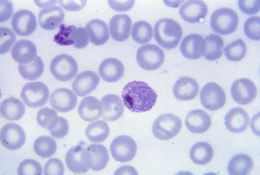September 27, 2016 report
Analysis of eradicated European strain of malaria parasite offers insight into the history of the disease

(Phys.org)—An international team of researchers has conducted a DNA analysis of malaria parasites found in blood samples taken from infected people in a part of Europe and put onto slides during World War II—in so doing, they have added more information to the historical profile of the parasite that causes malaria. In their paper published in Proceedings of the National Academy of Sciences, the team describes their analysis of the parasite samples and what they learned.
Malaria is a disease caused by a protozoan parasite that takes up residence in a victim's red blood cells—transmitted by mosquitoes, it is responsible for the millions of deaths and untold suffering. Efforts to eradicate the parasite from all parts of the world have so far proved unsuccessful, though it has been eradicated in some regions, including Europe and the U.S. As part of an effort to rid the world of the deadly parasite, some researchers have been attempting to look into its past to spot a weakness, or at least to better understand how it evolves. Some research results have also suggested that the dispersal patterns of malaria are due to human movements between continents, which has caused some researchers to wonder if the migrations of people have somehow played a role in both its continued existence and the harm it causes.
In this new effort, the researchers came into possession of some slides with blood stains on them that had been taken from infected people in Spain during World War II—since malaria has since been eradicated in that area, the blood stains offered an opportunity to learn more about a strain that predates those that exist today.
The researchers first conducted tests to identify the strains present in the samples; after that, they reconstructed the genomes of the two strains present, which allowed them to conduct phylogenetic analyses. They report that they found three mutations that offered evidence of dominant strains of the parasite being carried to South America from Europe not long after explorers arrived; further, they represent the closest modern representative of ancestral Eurasian stock. The study and its findings are likely to kick off a renewed effort to comb other medical collections to see if other slides might be found offering more historical data as the effort continues to wipe out malaria and the parasite that causes it completely.
More information: Pere Gelabert et al. Mitochondrial DNA from the eradicated Europeanandfrom 70-year-old slides from the Ebro Delta in Spain, Proceedings of the National Academy of Sciences (2016). DOI: 10.1073/pnas.1611017113
Abstract
Phylogenetic analysis of Plasmodium parasites has indicated that their modern-day distribution is a result of a series of human-mediated dispersals involving transport between Africa, Europe, America, and Asia. A major outstanding question is the phylogenetic affinity of the malaria causing parasites Plasmodium vivax and falciparum in historic southern Europe—where it was endemic until the mid-20th century, after which it was eradicated across the region. Resolving the identity of these parasites will be critical for answering several hypotheses on the malaria dispersal. Recently, a set of slides with blood stains of malaria-affected people from the Ebro Delta (Spain), dated between 1942 and 1944, have been found in a local medical collection. We extracted DNA from three slides, two of them stained with Giemsa (on which Plasmodium parasites could still be seen under the microscope) and another one consisting of dried blood spots. We generated the data using Illumina sequencing after using several strategies aimed at increasing the Plasmodium DNA yield: depletion of the human genomic (g)DNA content through hybridization with human gDNA baits, and capture-enrichment using gDNA derived from P. falciparum. Plasmodium mitochondrial genome sequences were subsequently reconstructed from the resulting data. Phylogenetic analysis of the eradicated European P. vivax mtDNA genome indicates that the European isolate is closely related to the most common present-day American haplotype and likely entered the American continent post-Columbian contact. Furthermore, the European P. falciparum mtDNA indicates a link with current Indian strains that is in agreement with historical accounts.
Journal information: Proceedings of the National Academy of Sciences
© 2016 Phys.org

















